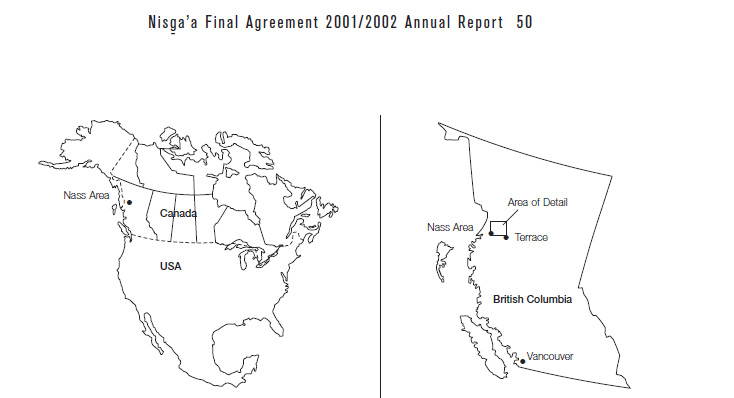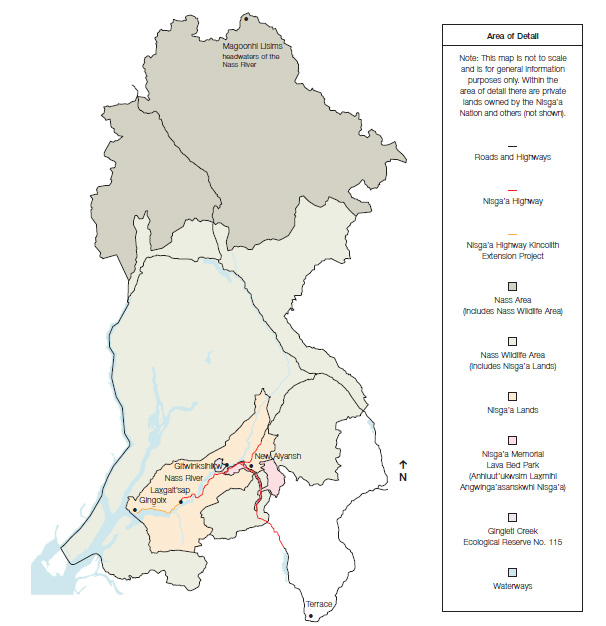'Prosper' - Nisga'a Final Agreement 2002 Annual Report
Author: Published under the authority of the Nisga'a Nation, the Province of British Columbia, and the Government of Canada.
New Aiyansh, British Columbia Victoria, British Columbia Ottawa, Ontario
Date: December, 2002
ISBN: 0-662-32957-0
QS- B030-010-EE-A1
PDF Version (3.48 MB, 55 Pages)
Table of contents
In 1998, the governments of Canada, British Columbia, and the Nisga'a Nation initialled the Nisga'a Final Agreement, British Columbia's first modern treaty. The Nisga'a Final Agreement sets out Nisga'a Lands and the Nisga'a people's right to self-government. The effective date of the treaty, May 11, 2000, marked the beginning of an evolution in governance, economic development, and cultural awareness within the Nisga'a Nation.
This report summarises the activities of the parties in the implementation of the Nisga'a Final Agreement from April 1, 2001 to March 31, 2002.
How do you measure the worth of a people?
GDP? Productivity? Debt-equity ratio? Communities around the world are beginning to question the criteria for success imposed by outsiders. They have developed their own ways of measuring the wealth, health, and well-being of their people. Unless "success" is defined by those who seek it, it will remain an illusive goal, an objective devised and judged by someone else, far removed.
Long before European colonisation, the Nisga'a people had developed an elaborate society based on communal responsibility. The Nisga'a people succeeded or suffered as a whole. Their economy was based on natural resources and they relied upon complex trading relationships with their neighbours. Now, through the Nisga'a Final Agreement, the Nisga'a people are once again defining themselves by their own standards and measuring success by their own criteria. What is prosperity? Is it wealth? Health? Knowledge? Culture? What tools are required to secure it? In order for a people to prosper, they must define who they are, where they want to go, and how they plan to get there.
A Model for Development
The Nisga'a Nation is working to support traditional culture, to cultivate new ways of economic and entrepreneurial thinking, and to establish the basis for a diversified and sustainable economy. In support of this goal, Nisga'a government is exploring partnership opportunities in fisheries, forestry, eco-tourism, hydroelectricity, and other areas. Nisga'a government is recruiting experienced business leaders to mentor and guide business development, and to help create a ten-year strategic plan that will set direction and identify the skills and training required for success. Throughout this process, care is taken to ensure the separation of political decision-making and business operations. Together with its partners in the governments of British Columbia and Canada, the Nisga'a Nation is redefining its economic potential.
The second year of implementation of the Nisga'a Final Agreement saw the building of economic capacity and infrastructure, the growth of opportunities and partnerships, and investment in sustainability for future generations. As the Nisga'a Nation explores new ways of ensuring its economic prosperity, it will continue to enrich the lives of its people in traditional ways — ways which cannot be quantified by the exchange of capital.

Killer whale clan, Matriarch, Laxgalt'sap., Interviewed at New Aiyansh, Recreation Centre
"This memorial is like lighting the fire in the Chief's house again.
Like the old people say, ‘They are beginning to see the light through their sorrow."
"This settlement feast is a memorial to the deceased. It helps pay for expenses and gives money back to the community. It's our way of taking care of each other. It's called yukw, which means feast. We matriarchs are the cooks. Bull cooks, our young men, do all the heavy lifting. They have to do what we tell them. We're working for our brother's three sons who are hosting the feast. We are following the culture our forefathers left us. Matriarchs baby-sit the culture. This is how it is passed down to a younger generation.
This memorial is like lighting the fire in the Chief's house again. Like the old people say, "They are beginning to see the light through their sorrow." When their mother passed away, there was no light left in their home. There is no light during the time the person dies and the body lies in state. Tonight, they are beginning to see the light. People will talk to them, encourage them. They will share a meal with the community and all the people who will come.
After the meal, there will be a bowl on the table. First the widower brings forward what money he has and puts it into the bowl, the common bowl. Then the rest of the Wolf tribe give their support for paying expenses. After the Wolf tribe, we will all walk up. Then they distribute the money. It goes to the undertakers, the hall, the cooks, churches, choirs... the community. When all the money is redistributed, they will announce that the bowl is empty.
Nobody leaves until they have eaten four bowls of Nisga'a stew. We say Haagwil di txooxkwsim', which means eat slowly. Don't leave until the feast is over. They will tell you when the feast is over."
A First Nation, Again
The Nass River flows through a land of rugged lava beds, dense forests, and sacred mountains on Canada's Pacific coast. In 1858, the British Crown created the Colony of British Columbia, which included the Nass Area where the Nisga'a Nation has lived since time immemorial. In 1887, the Nisga'a began petitioning government to recognise their ownership of, and rights to, Nisga'a territory. On August 4, 1998, the Nisga'a Final Agreement was initialled by the Nisga'a, Canada and British Columbia, in New Aiyansh. This marked the completion of a quarter century of negotiations.
On May 11, 2000, the effective date of the treaty, the Indian Act ceased to apply to the Nisga'a (except for the purpose of Indian Registration). This momentous day marked the end of a 113 year journey — and the first steps in a new direction. For the first time in modern history, through the self-government provisions of the treaty, the Nisga'a had the legal authority to conduct their own affairs. The treaty ended the uncertainty regarding land ownership and has opened the door for joint economic initiatives in the development of the Nisga'a Nation's natural resources. It benefits all Canadians.
News of the Nisga'a Final Agreement has travelled far beyond the Nass Valley — across British Columbia, Canada, and around the world. Governments and aboriginal peoples are all watching the implementation of the treaty with keen interest. They are also seeking the advice of Nisga'a negotiators and government members.
The Nisga'a Final Agreement serves as an example. It demonstrates that governments and First Nations can, in good faith, work together to forge a more secure future for everyone.
Nisga'a Lands
The Nisga'a Nation includes approximately 5,500 people. About half of Nisga'a citizens reside in the four communities on the Nass River: Gingolx (Kincolith), Laxgalt'sap (Greenville), Gitwinksihlkw (Canyon City), and New Aiyansh. A significant proportion of Nisga'a also live in the British Columbia urban centres of Terrace, Prince Rupert, and Vancouver. For administrative purposes, these urban communities are identified by Nisga'a government as Nisga'a "Urban Locals."
The Nisga'a Nation owns approximately 2,000 square kilometres of Nisga'a Lands in fee simple. Under the treaty, the Nisga'a harvest fish in the Nass Area (26,838 square kilometres), and harvest wildlife in the Nass Wildlife Area (16,101 square kilometres). Through their participation on management committees, established by the treaty, the Nisga'a provide advice and recommendations to federal and provincial government ministers on fisheries and wildlife management. Nisga'a government has the authority to make laws regarding the Nisga'a Nation's rights and obligations related to wildlife, migratory birds, fish, and aquatic plants.
British Columbia continued to survey the boundaries of Nisga'a Lands in 2002. This involved completing surveys of eight areas along the boundaries of Nisga'a Lands, including those portions adjacent to the Nisga'a Lava Bed Memorial Park and the Gingietl Ecological Reserve No. 115. Preliminary survey returns were submitted to British Columbia, Canada, and the Nisga'a Nation for examination.
The Nisga'a Nation has its own land title system and its own land registry, known as the Lisims Land Registry. The Lisims Land Registry is modelled on British Columbia's system. Since the effective date, the Nisga'a Nation has granted a total of 5,001 hectares of land to the four Nisga'a villages and, in turn, a total of 493 Village Entitlements have been granted to Nisga'a citizens. Additionally, through the Lisims Land Registry, 74 interests on Nisga'a Lands (including licences of occupation, rights of way, and special use permits) have been granted to over a dozen private and public institutions, including provincial government ministries, the RCMP, CBC, and Skeena Cellulose, Inc.
Representative, Responsible Government
The Nisga'a Nation has the right to self-government and the authority to make laws. Nisga'a government is composed of Nisga'a Lisims Government (NLG) and four Nisga'a Village Governments. The Nisga'a Nation acts through NLG, which consists of executive and legislative branches, as well as a Council of Elders. Each Nisga'a Village acts through its Nisga'a Village Government in exercising its rights, powers and privileges, and in carrying out its duties, functions and obligations.
The Nisga'a have always governed themselves according to Ayuukhl Nisga'a, the traditional laws and practices of the Nisga'a Nation. The Council of Elders provides guidance and interpretation of the Ayuuk to Nisga'a government. Composed of chiefs, matriarchs, and respected Nisga'a elders, the Council of Elders is appointed by NLG in accordance with Nisga'a law and the Nisga'a Final Agreement.
Nisga'a government is democratic, representative, and responsible to its citizens. The President, Chairperson, Secretary-Treasurer, and the Chairperson of the Council of Elders are elected by all Nisga'a citizens and serve as the four Officers of NLG. The Chief Councillor and Councillors are elected by Nisga'a citizens resident in each village. The executive consists of the Officers, the Chief Councillor of each Nisga'a Village Government, and one representative from each Nisga'a Urban Local.
Wilp Si'ayuukhl Nisga'a is the legislative body responsible for considering and passing Nisga'a Lisims Government laws. It includes every Officer of NLG, the Chief Councillor and Councillors of each Nisga'a village, and two elected representatives from each Nisga'a Urban Local. Wilp Si'ayuukhll Nisga'a has 39 members. During the reporting period, there were five sittings of the Wilp Si'ayuukhl Nisga'a (April 24-25, 2001, July 25-26, 2001, October 25-26, 2001, January 24- 25, 2002, and March 12-13, 2002). Eleven laws were passed along with numerous resolutions relating to the operation of Nisga'a government.
Under the terms of the Nisga'a Final Agreement, Canada and British Columbia provide annual capital transfer payments to the Nisga'a Nation until 2014. During the reporting period, payments of $20.3 million from Canada and $1.67 million from British Columbia were made to the Nisga'a Nation.
A Working Partnership
Because three governments share responsibility for the implementation of the Nisga'a Final Agreement, an Implementation Committee was formed to provide a forum for sharing information and ideas. The committee works to ensure that the treaty responsibilities are fulfilled in a timely manner, and to resolve issues that may arise. Canada, British Columbia, and the Nisga'a Nation report that the Implementation Committee has worked in a spirit of co-operation to ensure a smooth transition of authority. Communication and co-operation between the parties continues to mature as the implementation moves forward. This report, funded by the federal Department of Indian Affairs and Northern Development, summarises the progress made by the parties in the second year of treaty implementation.
Experience Gained, Experience Shared
Nisga'a representatives have traveled across Canada and abroad relaying the Nisga'a experience in both treaty-making and treaty implementation. During the reporting period, members of Nisga'a Lisims Government participated in numerous conferences and symposia, including: the Summit of the Americas in Quebec City, the Aboriginal Governance Conference in Yellowknife, the Assembly of First Nations Annual General Assembly in Halifax, the Northwest First Nations Governance Symposium in Prince George, and the British Columbia Provincial Congress in Vancouver.
Hak'ak'a'a, the official newsletter of Nisga'a Lisims Government, is produced bi-monthly to tell the story of the implementation of the treaty. Editions are posted on the NLG web site and are distributed to Nisga'a citizens, the media, and business and government leaders.
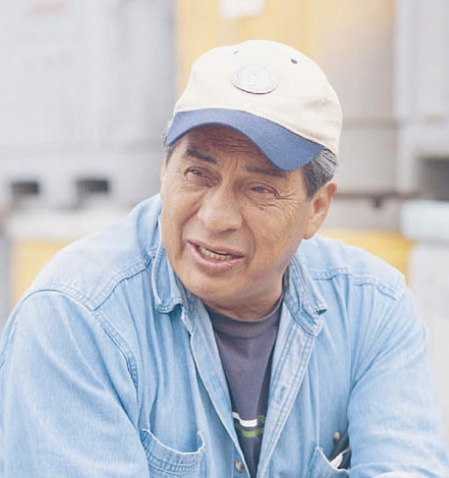
Raven Clan, Transportation and Maintenance Supervisor, Nisga'a Fisheries. Interviewed at the Old Aiyansh fish landing site.
"We are not the kind that follow, our people create their own objective."
"I was born on a gill-netter. My family was moving home to Gitlaxt'aamiks from Prince Rupert and I showed up around Gingolx. It was pretty rough, my mother had me in the boat. My parents had eight children, our father supported us on odd jobs and fishing.
I fished with my uncles when I was ten years old. My first job was in the cannery. It's been a hard life. We didn't have anything. We were isolated and didn't know what was going on in the outside world. I've been here all my life, except for when I was shipped out to a residential school. We were bewildered when we went out, we were lost. It was an experience a person doesn't like to talk about.
I've been a fisherman, a logger, a trucker, a jack-of-all-trades. Then last year, I was posted with Nisga'a Fisheries. I drove trucks for them. This year they gave me a promotion to supervisor and co-ordinator of their machinery movement. I co-ordinate all this machinery, trying to cut costs, making it more efficient. It has worked well for me. I enjoy working here.
The way I see it, there are two kinds of people, two different temperaments: you are either a doer, or you're not. Most of our people are doers.
Employment from fisheries is a new thing for our people over the past ten years. You can see the changes coming. They are tremendous; they have affected our lives. I think people are finally starting to grasp the whole idea that this fishery is also ensuring sustainability for the future. Nisga'a Fisheries is creating something for our grandchildren and their grandchildren. On other rivers, they're running short of fish — not these rivers. Here you can see the improvement coming, the stocks are coming back.
We are not the kind that follow, our people create their own objective. If our government stays on this steady improvement, it will work fine for everyone. Not just the Nisga'a, but everyone in the valley. We employ people from outside the villages, not just Nisga'a people. It's a good atmosphere to be in. You are not just employing our people but other people too.
But this treaty is just starting to create the work our people have needed for years. A few years ago, I figured we were just changing the colour of the fence that was around us... But now we are governing our own people. We're the only ones who have a say and we're the only ones who are accountable for the changes that come about. It can go down or up — it all depends on the people. We weren't sure about the treaty at first. Like everything else, it takes time. If we're patient enough, we'll see the fruits of it."
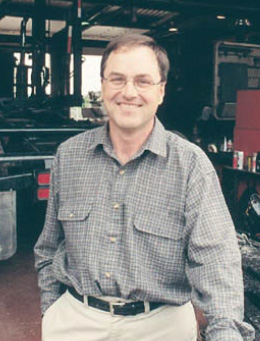
Dealer-Manager, Inland Kenworth. Interviewed at the Terrace Service Centre.
"The Nisg a'a are an important part of the local economy in Terrace. Without them, our downtown would be in serious trouble."
"The Nisga'a are an important part of the local economy in Terrace. Without them, our downtown would be in serious trouble. We've lost almost all our industry. The Nisga'a people have been massive supporters of the downtown businesses — clothing stores, grocery stores, hotels. We would be in very serious trouble without the Nisga'a.
We've been involved with the Laxgalt'sap Forest Corporation since the beginning. We sat in right from the start, when it was just a concept. It's been on a steady incline. They've purchased well over $1 million worth of equipment in the last five years — five trucks, one self-loader, a log loader, and a road-builder. We've also sold a new truck to Nisga'a Fisheries. The Nisga'a have become a large part of our business. I see their role expanding as time goes on, as they update and increase their business volume.
For a brand new company, Laxgalt'sap Forest Corporation has grown by leaps and bounds. Some things go up and down, but the general trend is that it has been climbing like a sustainable business. Their core lands have lots of timber, and they have found markets for it. It's coming together for them. There's a ton of potential in the Nass Valley. They bring a huge amount of money into town."
A River Rare
The Nass River is the lifeblood of an uncommonly rich watershed. It ties Nisga'a villages to each other and Nisga'a Lands to the sea. It connects the past to the future.
For thousands of years, the abundant salmon and oolichan runs of the Nass River were harvested in a manner that allowed the Nisga'a people to build and sustain their villages, and to develop trading relationships that extended into the interior and ranged up and down the coast. Under the Nisga'a Final Agreement, the Nisga'a have the right to fish throughout 26,838 square kilometres of territory known as the Nass Area.
Nisga'a Fisheries
For the Nisga'a Nation, participation in the management of the fishery is vital for both cultural and economic reasons. Recognising this, Canada and the Nisga'a Nation established Nisga'a Fisheries in 1992 to co-operatively manage the resource. The treaty allows for the commercial sale of salmon and this new revenue has enabled the communities to benefit significantly.
In the 2001 fishing season, 800 Individual Sale permits were sold to Nisga'a citizens for a chance to participate in eight Individual Sale Fishery openings. During the Individual Sale Fishery, 103,860 kilograms of salmon was caught, which represents $386,126 in revenue to Nisga'a fishers and $162,908 to Nisga'a Lisims Government. The domestic harvest, for internal consumption reached the target of 13,454 salmon. Due to the effective interaction, co-ordination, and information exchange between Nisga'a Fisheries and the federal Department of Fisheries and Oceans (DFO), the harvesting amounts were based on abundant levels of fish that were accurately predicted. The quality of the information collected also allowed a targeted coho troll fishery, which was open to all commercial fishers in the area.
Nisga'a Fisheries continues to invest in the future. During the reporting period, NLG purchased a new aluminium patrol boat named Lihlksim Lisims or Protector of the Nass. Sixteen Nisga'a employees were trained for swift water rescue and 12 were trained in first aid. A new fishing landing site was constructed at Gitwinksihlkw for offloading, counting, and weighing salmon under the direction of Nisga'a Fisheries. In its first year of operation, it was used for 221 government-inspected landings. In addition, the Nisga'a Fisheries fresh fish plant at New Aiyansh was improved with a loading dock and control depot for shipping Individual Sale fish. Over 100 people worked for Nisga'a Fisheries during the 2001 season.
Co-operative Fisheries Management
The Joint Fisheries Management Committee (JFMC), a tripartite fisheries body established by the Final Agreement, recommended the Nisga'a annual fishing plan to DFO. With six members — two each appointed by the Nisga'a Nation, Canada, and British Columbia — the JFMC facilitates the co-operative planning and conduct for Nisga'a fisheries and enhancement in the Nass Area.
In a post-season review of the 2000 fishing season, through the Technical Fisheries Working Group, DFO and the Nisga'a Nation identified necessary changes to the fish allocation criteria. The JFMC agreed with the recommendations and adjusted the Fisheries Operational Guidelines. These changes resulted in greater accuracy in estimating fish allocations. Details of these changes were discussed with interested groups throughout the region prior to their finalisation and inclusion in the 2001 Nisga'a Fishing Plan.
In 2001, Nisga'a Fisheries undertook pink/chum escapement studies at Ksi X-anmas River using hydro-acoustic technology, and underwater video cameras were used to improve methodology for estimating Chinook/pink escapement. An assessment of crab stocks also continued.
During the reporting period, a joint steelhead stock assessment project was funded and undertaken by Nisga'a Lisims Government and B.C An aggregate population estimate was produced for the Nass River summer steelhead run as part of the fish wheel assessment project. British Columbia amended its Angling Guide Licences to reflect Nisga'a Final Agreement provisions and provided $13,000 to the Nisga'a "Herring Spawn on Kelp Feasibility in the Nass Area" study.
Co-operative management of the resource has extended beyond the three parties. Under a Canada/U.S. initiative, the Nisga'a Nation was included in technical discussions on the assessment of Northern Boundary Sockeye. The results of the joint analysis produced a common international approach for sockeye assessment and accounting.
Product Development
Building strategic partnerships outside the Nisga'a Nation is a priority for Nisga'a Fisheries. In 2000, NLG entered into an alliance with Canadian Fishing Company (Canfisco) to process Nisga'a commercial fish. Canfisco supplied Nisga'a Fisheries with personnel, fish totes, and expertise in processing fish. Beginning in 2001, five percent of the annual catch is now utilised for value-added products, including premium quality, specially labelled Nisga'a wild sockeye salmon.
Lisims Fisheries Conservation Trust
Nisga'a Lisims Government is committed to ensuring a healthy, productive aquatic ecosystem for the benefit of present and future generations of all peoples. In pursuit of this goal, NLG applies the highest possible standards in the areas of conservation and environmental protection. That commitment is ensured, in part, by the Lisims Fisheries Conservation Trust.
Managed by trustees appointed by the NLG and Canada, the Lisims Trust promotes conservation and protection of Nass Area fish species; facilitates sustainable management, watershed restoration, and wildlife habitat restoration; and supports Nisga'a participation in fisheries stewardship for the benefit of all Canadians.
Developmental Lending
Nisga'a Lisims Government has entered into a Loan Fund Management Agreement with Tricorp, a lending institution focused on First Nations, to provide developmental loans to Nisga'a commercial fishers that are licensed by the Department of Fisheries and Oceans. This new initiative provides Nisga'a fishers with an additional source of financing in the form of low-interest loans and partial loan forgiveness for start-up and operating costs. This Loan Fund Management Agreement opens up new opportunities for Nisga'a commercial fishers. During the reporting period, 63 Nisga'a fishers took advantage of the program.
Hydroelectric Power Generation
Under the terms of the Nisga'a Final Agreement, the Nisga'a Nation is able to investigate the hydroelectric power potential of unrecorded waters in streams (other than the Nass River) that flow wholly or partially within Nisga'a Lands. Now that the question of land ownership is settled, exploration of this opportunity can begin.
Like much of the rest of British Columbia, the rivers and streams within Nisga'a Lands are rich in energy potential. During the reporting period, Nisga'a Lisims Government and a Vancouverbased energy company began reviewing hydrology data with the goal of developing small-scale "run of river" class hydroelectric generating facilities in the Nass Valley, both on and off Nisga'a Lands.
Hydroelectric power generation would be useful in promoting economic development on Nisga'a Lands. With greater energy generating capacity, Nisga'a communities would have an important asset to attract business to the Nass Valley. Should it be successful, this project has the potential to not only provide power for the Nisga'a Nation, but also to provide NLG with the opportunity to negotiate the sale of surplus "green" electricity back to the provincial power grid.
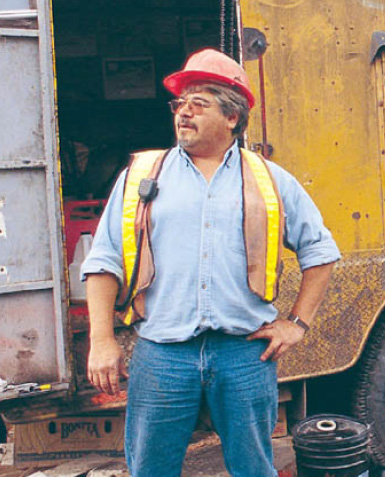
Wolf clan, Manager, Laxgalt'sap Forest Corporation. Interviewed at Laxgalt'sap log sorting site.
"…the treaty is not a book of guarantees — it's a book of opportunities."
"Change is happening, but it's happening slowly. Slowly but surely. One of the things that we've known all along is that the treaty is not a book of guarantees — it's a book of opportunities. It means that opportunities are there, but nothing will be handed to us on a silver platter. We have to work for what we get. This is the real world. If anyone thinks that it's one big handout, they need a reality check. They're dead wrong.
Laxgalt'sap Forest Corporation is a community-owned company. The board of directors is completely separate from the village government. The company was in existence before the treaty, but now with the treaty in place we have this opportunity. Before the treaty, we weren't able to have our own contractors. Now the majority of the work is with Nisga'a contractors. That's a nice change. Nisga'a have control over their resources on their own lands. It wasn't like that before.
We're not tied to the domestic markets, but the rules of general application still apply as far as the resource goes. We're able to put some of our timber on the export markets in Asia — to the Japanese, Koreans and Chinese. All this is through the treaty. We also have some local sales to guitar and violinmakers, like Timbertone. They like our white spruce.
Our company still doesn't have a long-term tenure. That's one of our goals — as is the possibility of a value-added secondary manufacturing facility. All these were not possible before the treaty, now they are possible. Opportunities exist, but you will not get them if you just sit back and wait for them to come to you.
It will all fare well providing the government listens to the people. The people know what's best. But this is just the second year. We're barely into the first phase of our treaty; not even the first full term of our government. It needs time — we'll get everything squared away and on track. In the meantime we will continue to work, have our company grow, and have most of our people working.
I envision our company being one of the major companies within the northern district. Not just the Nass Valley. We have nearly 30 guys working here; Nisga'a and non-Nisga'a. I don't care who they are as long as they can do the job. Without the treaty, there would be no jobs here for any of them.
We can sit around and still be in a treaty, but unless we get up and start going after the opportunities, we will be just as dormant as we were before. Opportunities are just that: opportunities. They will stay opportunities unless we capitalise on them and turn them into success stories."
A Land of Plenty
The Nisga'a Nation enjoys an abundant natural environment. At home on the Pacific Rim, in the heart of the world's largest temperate rain forest, the Nisga'a people rely on a rich ecosystem that includes salmon, cedar, and fur-bearing mammals. Nisga'a lands and forests provide the foundation upon which the Nisga'a people have built a culture and economy that respects and protects the natural world.
Under the Nisga'a Final Agreement, the Nisga'a Nation owns Nisga'a Lands and controls the resources on those lands. They are managing their resources for long-term sustainability.
Forest Management
The Nisga'a Final Agreement stipulates that Nisga'a forestry practices must meet or exceed standards established under provincial forestry practices legislation for Crown land. Nisga'a Lisims Government is committed to meeting this requirement while providing consistent, sustainable employment for forestry workers.
The treaty provides for a five-year transition of the control of timber harvesting and management on Nisga'a Lands from British Columbia to NLG. During the transition, B.C., under provincial forestry legislation, licenses the harvest of an annual volume of timber to forest companies who held licences prior to the treaty's effective date. While these licences are issued by B.C, both the Province and NLG, through the Forestry
Transition Committee, have a shared responsibility in the administration of the licences. At the end of the transition period, in 2005, the Nisga'a Nation will have full control of Nisga'a timber.
Under the transition arrangement, forest licensees must harvest specified volumes of timber each year and a percentage of the volume must be contracted to Nisga'a citizens to harvest. In the second year of the treaty, the target of 70 percent Nisga'a contractors was exceeded.
During the reporting period, a total of 74,469 cubic metres of wood was harvested under the transition licences, much of it by communityowned Laxgalt'sap Forest Corporation which employs 30 people. To support operations, 9.6 kilometres of logging road were constructed during the reporting period. Continuing volatility in North American lumber markets has underscored the need for long-range planning. That's why Nisga'a operators are making significant capital investments to ensure they are well positioned to meet increasing demands as markets recover.
Forestry Transition Committee
The Forestry Transition Committee, comprised of one person each from NLG and B.C, has authority to approve forest development plans throughout the five-year transition period. The committee approves silviculture plans and issues all cutting and road permits in the latter years of the transition period.
During the reporting period, the committee received a proposed Forest Development Plan from Skeena Cellulose Inc. (SCI), the major licensee on Nisga'a Lands. The plan was sent to the Joint Fisheries Management Committee and Nass Wildlife Committee for review and comment, made available for public consultation, and ultimately approved. In 2001, British Columbia transferred quarterly Same Economic Position (SEP) payments, totalling $446,806 to the Nisga'a Nation for timber harvested on Nisga'a Lands. Under the SEP arrangement, the Nisga'a Nation receives a payment of $6 per cubic metre, and an additional amount if either billed stumpage or industry performance exceeds $6 per cubic metre. Nisga'a Lisims Government and B.C are still seeking agreement on the criteria for calculating the conversion factor for determining industry performance.
Loggers' Development Assistance Program
The Loggers' Development Assistance Program is designed to help Nisga'a forestry contractors survive the depressed lumber market. The program, created by NLG during the reporting period, will help Nisga'a logging companies by providing low-interest loans.
Mushroom Harvest
The Lands and Resources Directorate of Nisga'a Lisims Government manages all land and forest resources on Nisga'a Lands, except for timber harvesting under provincial licences during the transition period. Pine mushrooms, a popular delicacy in Asia, are the second most valuable resource found on Nisga'a Lands. NLG is among the first governments in Canada to establish a management plan for the harvest of this renewable resource. At 27,216 kilograms, the 2001 mushroom harvest was double the size of the previous year's and added more than $1.3 million to the local economy.
NLG licenses mushroom pickers and buyers. While the licensing program has been in place since the effective date, enforcement was gradually introduced in the 2001 season. Education has resulted in good compliance by both pickers and buyers, and licensing fees provide a reliable source of revenue for continued management of the resource.
Wildlife Management
The Nass Wildlife Committee, a tripartite body created under the Nisga'a Final Agreement, provides advice about wildlife management and harvest within the 16,101 square kilometre Nass Wildlife Area. British Columbia uses this information to establish the total annual harvest levels and approves the annual Nass Wildlife Management Plan.
During the reporting period, the committee monitored developments on the Nisga'a Highway Kincolith Extension Project, reviewed the Kalum Land and Resources Management Plan document, and discussed both pending "species at risk" legislation and angling guide opportunities. Under the terms of the Fiscal Financing Agreement, B.C provided $20,000 to the Nisga'a Nation for Nisga'a participation on the Nass Wildlife Committee.
Moose, grizzly bear, and mountain goat populations are the focus of the annual Nass Wildlife Management Plan. Ongoing research determines population estimates for these species within the Nass Wildlife Area. From these estimates, Total Allowable Harvest quotas are determined to calculate annual allocations. During the reporting period, the moose population was estimated to have been approximately 1,400 and the Nisga'a allocation was 126. The grizzly bear population estimate was 400 animals. With conservation as the overriding principle, the Total Allowable Harvest was determined to be five grizzlies, of which the Nisga'a allocation was two. The mountain goat population was found to be over 3,000 strong; this allowed an allocation of 34 to Nisga'a hunters.
Tourism Development
As an economic engine, British Columbia's tourism industry is second only to forestry. Much of the success of this industry is tied to the province's renowned natural beauty and wildlife. The Nisga'a Nation is eager to take part in B.C's tourism sector by showcasing its stunning natural environment and rich cultural heritage.
To help attract visitors to the Nass Valley, British Columbia issued a commercial recreation tenure to the Nisga'a Nation. NLG, in turn, designated Lisims Backcountry Adventures, Inc. as the recipient of the tenure. The company is preparing to offer wilderness tourism experiences, including wilderness viewing, sport fishing, and hiking. Negotiations continued with several potential industry partners and Lisims Backcountry Adventures plans to begin operations in 2003.
Offering visitors remote wilderness fishing holidays, Wilp Sy'oon (House of Glacier) fishing lodge began operation in 1996. Accessible only by boat or floatplane, the lodge is located approximately 30 kilometres south of Gingolx near Pearse Island. Charter companies fly guests between Prince Rupert and the lodge. Wilp Sy'oon continued to be featured in some of North America's premier sport fishing magazines and television programs. In 2001, eight Nisga'a citizens were employed at the lodge.
Anhluut'ukwsim Laxmihl Angwinga'asanskwhl Nisga'a
The Joint Park Management Committee (JPMC), comprised of members from the Nisga'a Nation and British Columbia, jointly manages Anhluut'ukwsim Laxmihl Angwinga'asanskwhl Nisga'a, or Nisga'a Memorial Lava Bed Park. The JPMC was established in 1992, and continues under provisions of the Nisga'a Final Agreement. During the 2001 season, approximately 1,600 people were welcomed at the visitors' centre and nearly 400 camping parties used the campground at Nisga'a Memorial Lava Bed Park. Visitation continues to grow slowly, but with the completion of the Nisga'a Highway upgrade, the park has the potential to attract thousands of visitors to the region's rich natural and cultural resources.
BC Parks, with advice from the JPMC, continued to develop business opportunities utilising the park visitor centre, campground, and guided trail to the volcano crater. The JPMC discussed private land access through the park, angling guide regulations, highway projects, and general park operations.
British Columbia funded two Environment Youth Team Interns, an Assistant Park Ranger, a Visitors' Centre Co-ordinator, an Environmental Youth Team Crew (consisting of one supervisor and five members), and a park maintenance contract to a Nisga'a resident.
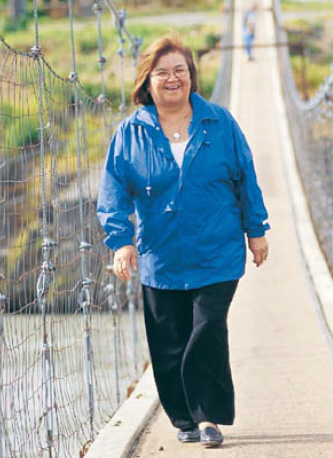
Raven clan, Community Health Representative (CHR), Gitlaxt'aamiks Winner, 2002 Natinoal CHR Award. Interview at the old supension bridge.
"You can't ignore the power of example."
"When I was a little girl in Gitlaxt'aamiks, we were isolated. We travelled mainly by river. My dad was a fisherman, my mom worked in the fish plant. We lived comfortably and we always had what we needed. My father believed in education. He encouraged me and gave his support. They were our role models. Having a job and providing for your family plays into your health. I think it's all part of being healthy.
I've been a Community Health Representative for 32 years. I was trained to deliver first aid and basic health care services. We're involved in health teaching and prevention programs. I like it because it's different every day. We teach first aid, give medication, and bring in doctors. We are also trained to deliver babies — although I haven't done it yet. There are over a thousand of us in Canada.
Over the years, I knew that I needed my General Education Diploma. Then Nisga'a Valley Health Board sent me away to do a course. My grades were so good I was encouraged to continue. Then Wilp Wilxo'oskwhl Nisga'a (WWN) opened and I took culture and language courses every semester. I earned a bachelor's degree while working full-time. I wanted that degree. Because I work full-time, WWN was the only way I could have done it. Having WWN in the Nass Valley is very important.
My husband was my number one supporter. He did the cooking, cleaning, and laundry. I never went to feasts, because I was working and studying. I graduated in 2001. My education helped me get my promotion to a supervisory position. It helped me advance to the next level.
My son went back to school when he saw what I was doing — watching me do my homework and going to WWN. He went back and graduated from high school this year and now he wants to go on to college. You can't ignore the power of example.
We need to work really hard to make this treaty work for us; to make it meet the people's needs. Throughout the treaty process, we saw that there was a need for our own people to have degrees, to develop programs. We are able to sit down and decide what kinds of programs are appropriate. We listen to the people, then do it ourselves. We know the community and can make decisions about community health care. The more we have our own people managing or supervising, the better. It's about control and getting appropriate services.
I think there are more opportunities for my children and grandchildren. The students that just graduated are all going to WWN, they have worked hard to go to college or university. We have to show our kids what the possibilities are. There are some good opportunities, but they need the educational background in order to see them."
Society of the Whole
Nisga'a culture is based on an ancient system of contribution and sharing known as Saytk'ilhl Wo'osim', or "common bowl." In Nisga'a society, it is understood that everyone relies on the same resources and community; therefore, all must contribute. Today, Nisga'a government delivers education, health, and social services under this guiding principle. As Nisga'a government policies and programs continue to evolve, the common bowl concept of fairness will continue to guide the way.
Nisga 'a Valley Health Board
Nisga'a government believes that community involvement in health care is critical to the health and well-being of its citizens. In 1989, the Nisga'a began managing their own health care system through the Nisga'a Valley Health Board. Registered under the Society Act, the Nisga'a Valley Health Board includes representatives of the four Nisga'a villages, and an elected representative from the non-Nisga'a community. The board is responsible for creating and maintaining facilities and promoting medical and public health care programs. Nisga'a Valley Health Board operates a diagnostic centre at New Aiyansh and satellite clinics in the other villages.
The Nisga'a Valley Health Board continued to provide health services to the Nisga'a regions as outlined in the Transitional Funding Agreement. Discussions continued between the Nisga'a Valley Health Board and British Columbia about the contract for service provision in the Nisga'a region. Initial discussions began between the Northern Health Authority and the Nisga'a Valley Health Board regarding roles and responsibilities. While Provincial Health Authorities were restructured from 52 to 6 during the reporting period, the Nisga'a Valley Health Board remained an independent, unique health authority with a direct relationship to the provincial ministries of Health Services and Health Planning.
During the reporting period, Nisga'a Lisims Government contributed $200,000 to the Nisga'a Valley Health Board for the delivery of health care services, and British Columbia contributed $1,310,518 specifically for physician, diagnostic, and treatment services.
Under the Fiscal Financing Agreement, Canada transferred $34.8 million to NLG to support the delivery of programs and services in the areas of health, education, social programs, income assistance, and local services.
Child & Family Services
As part of its responsibility for child and family services, Nisga'a Lisims Government has been delivering family support services and special needs programs since 1994. Since the effective date, Nisga'a Child and Family Services (NCFS) has also been preparing to provide foster care. Seven people are employed in NCFS, working directly with the four communities. NCFS also owns and operates a care home in Terrace for Nisga'a children in foster care transition.
NCFS solicits advice from the four communities through the Joint Management Committee, which includes representatives from the village governments, Community Resources Committee, and social development workers. NCFS acts as an advocate for families and children in crisis and offers various family support and recreation programs in Nisga'a villages.
In May 1996, British Columbia entered into an agreement with the Nisga'a Nation which enabled NCFS to deliver a wide range of family support services. In January 2002, British Columbia and NCFS entered into an agreement for Phase 2 services, which include guardianship and support services to Nisga'a residing on or off Nisga'a Lands. B.C provided $152,000 during the reporting period, which enabled NCFS to hire three professional social workers. This has given NCFS the resources to study and approve foster homes and group homes as well as the ability to take over guardianship responsibilities for Nisga'a children in the Terrace-Prince Rupert areas who have been in the care of the Province. Negotiations regarding the devolution of most child welfare services from B.C to the Nisga'a Nation continued.
Primary & Secondary Education
Nisga'a Lisims Government recognises the importance of education in fostering and protecting Nisga'a language and culture. Approximately 560 Nisga'a students in the Nass Valley are enrolled in bicultural and bilingual courses. In the Nass Valley, K-12 education is provided by British Columbia through School District 92 (Nisga'a) school board.
During the reporting period, B.C's Aboriginal Education Branch delivered a workshop to School District 92 (Nisga'a) on the advantages of establishing enhancement agreements between school districts and local aboriginal communities. Enhancement agreements provide detailed plans to improve aboriginal student achievement and address specific performance and delivery expectations for aboriginal learners enrolled in public school.
Higher Learning: Wilp Wilxo'oskwhl Nisga'a
Since 1993, Wilp Wilxo'oskwhl Nisga'a (House of Wisdom) has offered Nisga'a-based postsecondary programs in Nisga'a communities and Urban Locals. Scholars from as far away as Japan, Europe, China, and New Zealand have come to the Nass Valley to study at this institution of higher learning.
Serving both Nisga'a and non-Nisga'a students, Wilp Wilxo'oskwhl Nisga'a (WWN) partners with a number of public institutions for the delivery of programs. Through an affiliation with Northwest Community College, WWN offers vocational and technical training, Grade 12 achievement, and university/college preparation. Through an affiliation with the University of Northern British Columbia (UNBC), WWN offers a Bachelor of Arts in First Nations Studies, Nisga'a. Registration and enrolment increased in the Bachelor of Arts program to over 100 students during the reporting period. The program has enjoyed tremendous success with 13 students completing Bachelors of Arts degrees, 17 students graduating from vocational/technical programs, 32 students completing certificate requirements, and over 2,500 course completions to date. WWN is also working to establish a Masters program with UNBC.
Under the terms of the Nisga'a Fiscal Financing Agreement, Canada contributed $200,000 and British Columbia contributed $226,000 for the support of post secondary education and training programs. WWN also obtained an Indian Studies Support Program grant of $170,000 from the federal government. Nisga'a Lisims Government contributed $200,000 to WWN.
A grant from Human Resources Development Canada to WWN allowed for the launch of a Global Positioning System and Geographical Information System course. This highly successful course — the only one of its kind offered in Northwest B.C — has attracted students from various Nisga'a government departments. The skills acquired through this course are already returning to the community through ecological, economic, and cultural initiatives.
Access to Justice
The federal Aboriginal Justice Strategy provides funding to NLG for access to justice programs. These programs encourage the revival of relevant traditional Nisga'a justice practices, develop alternative programming, assist victims of crime, encourage crime prevention, and foster restorative justice.
The relationship between NLG and the federal justice system is notable for its innovation. In the prosecution of fisheries offences, for example, federal prosecutors act on behalf of the Nisga'a Nation and prosecute violations under Nisga'a law. This legal relationship is unique in Canada.
Outreach to Urban Nisga'a
Nisga'a Lisims Government is dedicated to ensuring that its citizens have access to aboriginal programs and services. Through its urban offices, Nisga'a Child and Family Services serves Nisga'a living outside the Nass Valley, providing support and fostering a sense of community for Nisga'a living in Terrace, Prince Rupert and Port Edward, B.C NLG purchased the former Elks Hall in Prince Rupert in 2001. This facility will serve as the centre for the delivery of NLG programs and services for Nisga'a citizens living in the Prince Rupert region.
Ayuukhl Nisga'a Department
The Ayuukhl Nisga'a Department (AND) of Nisga'a Lisims Government protects, preserves, and promotes Nisga'a language, culture, and history. AND responds to requests from citizens and governments for information on a variety of cultural issues, from Nisga'a spelling and syntax to traditional land use systems and cultural practices.
The AND collection consists of archival, historical, and contemporary documents regarding the Nisga'a Land Question, and general Nisga'a history and culture written by academics, anthropologists, and scientists. During the reporting period, AND played a key role in the development and approval of Nisga'a Nation's flag, the completion of the Canadian Museum of Civilization Custodial Agreement, the creation of the Nisga'a Treaty Gallery at the Royal British Columbia Museum, the securing of copyright for NLG's hayatskw (crest) design, and the completion of the speaker's chair in the legislative assembly.
Public Safety & Fire Prevention
Nisga'a Lisims Government was identified as one of the stakeholders for the Safety System Transformation Project undertaken by British Columbia. This project will ensure public safety by consolidating and updating safety system acts and regulations for fire prevention, electrical equipment, gas installations, and boiler systems.
At the request of NLG, the Fire Chief for the New Aiyansh Village Government was appointed in February 2002 as a Local Assistant to the Provincial Fire Commissioner under the Fire Services Act. The Local Assistant ensures the application of provincial legislation in the investigation of fires where there is loss of property
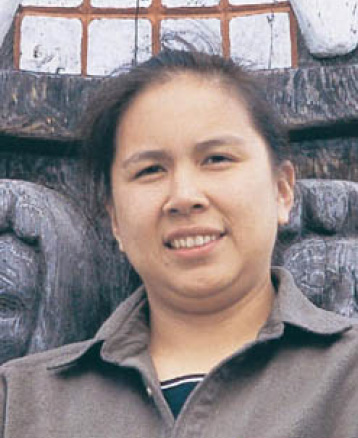
Eagle clan, Teacher, Nisga'a Elementary Secondary School, New Aiyansh. Interviewed at the Unity Pole.
"…they not only have pride in being Nisga'a, but also pride in being Canadian. That is a definite change."
"This is my first full year of teaching. I graduated from this school in 1992. I went on to study for two years at WWN, then completed my studies at UNBC. I wanted to show people that we could do it all here, that we could do it as well as anyone else. My dad teaches here. He taught here for years. It gave me the idea I wanted to be a teacher. My own children go here now.
I try to include Nisga'a language in the classroom. I'm not fluent, but I do encourage the kids to use what we know. We try to incorporate our language and culture into everyday things, not just special occasions. This year we learned about Hobiiyee, Nisga'a New Year. It's held in
February, the beginning of our harvesting year. It begins with the return of the oolichan. It's the beginning of the end of winter, the beginning of the rebirth of the environment. It has to do with the position of the moon. If you imagine the crescent moon shaped like a bowl, you want the full part of the moon on the bottom to show that it can hold the harvest. If it's tipped on its side, the bowl won't hold much and the harvest won't be as good.
With the treaty, I think there will be a definite change — for the better. These students are growing up knowing that there is a treaty. They understand and appreciate that they need the education to get meaningful employment for the rest of their lives. Maybe 50 percent say they are going to WWN. It was awesome to hear them say that. Education, experience — they need this. How else are we going to fill those positions that are coming up?
I think the treaty is having the biggest effect on the younger population. For these kids, it really impacts them because they live with it every day. I think they are proud of it. I took them to Prince George and they were excellent ambassadors of their family, school, village, and nation. That creates more pride. I notice it with my daughter and kids her age. They say they not only have pride in being Nisga'a, but also pride in being Canadian. That is a definite change."
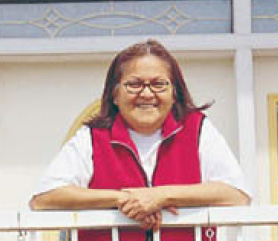
Eagle clan, Owner/Operator, Lavinia's Bed & Breakfast, Gingotx. Interviewed between lunch and dinner.
"If you have a dream, and you want to start a business — follow your dream."
"We moved back to Gingolx from Port Edward, B.C in September 2001. I wanted to start a bed and breakfast but I didn't know how to treat non-Nisga'a people when they come by. My oldest daughter said, "Treat them just the way you treat us. Remember they are the same people as we are, they aren't any different. Don't try to be someone you aren't — it will drain you."
I didn't know who to talk to or how to start it. I'd never even been to a B&B. I ask my guests questions about other B&Bs, and they tell me what I need to know. The village didn't have a hotel or any other business like a B&B. I bought everything we needed and brought it up by barge. I haven't regretted it.
I love what I'm doing so it's easy for me. I cooked for all my children, now I'm doing the same thing again. I get up at 6:30 and do my breakfasts, at ten I start my lunch, and then start supper at five o'clock. I still have time to do my speed walk and look after my flowers.
I'm usually full. It's word of mouth. I've had the RCMP, government people, lots of instructors, construction workers and their wives. Guests like to look out and see the tide go in and out. They like to watch the eagles, walk up to the hatchery, walk up and down the village. People from Alberta, Vancouver, Germany — all over. I try to make them as comfortable as I can.
My guests are looking for an impression of the Nisga'a people. They want me to sit with them at the table and talk about our people and what we do, how we go about our traditions. So we talk about that and exchange views. I cook a lot of traditional food: crab, herring eggs, seal, sea lion, cockles, clams, sea prunes, Chinese slipper, black cod, halibut and all kinds of salmon, plus salmon berries, soap berries, jam, and Indian ice cream. They are amazed when we have feasts. Sometimes they want to learn our language. They get excited about that.
With the road opening up, some of the people are excited and are really looking forward to driving up to visit their families. We want to be connected with the other villages. But I think that there are a few people who are kind of afraid of it. The community will change. But I'm excited, I just thought it was a golden opportunity to start my business.
Since the treaty, people are looking to start up businesses. Some people want to start up a bus company. We need a garage here. One young guy said he wanted to start a gas station. Other B&Bs will open, but I'm not worried. I know I'll have competition, but I think the demand will grow. In the meantime, I'm making renovations; I'm reinvesting. I want the place to be as comfortable as it can be. I added some more guestrooms last year. I have eight now.
It's a challenge. I think you have to be very positive when you start something up. I was afraid, but I worked... If you have a dream, and you want to start a business — follow your dream. Go for it."
A Path Made Clear
Now more than ever, prosperity depends on reliable transportation and communication. As economies and cultures become increasingly integrated, connecting the Nisga'a people to each other and the outside world is critical to the success of both government and business initiatives. It's about building pathways — both literal and virtual — to opportunity.
Road construction continued in the Nass Valley during the second year of the treaty. Both the Nisga'a Highway Upgrade Project and the Kincolith Extension Project are providing employment for Nisga'a people. While road crews worked to link Nisga'a villages to each other, Nisga'a Lisims Government also began laying the groundwork for opening modern communication pathways to the world.
Nisga'a Highway Upgrade Project
Funded by British Columbia, the $52 million Nisga'a Highway Upgrade Project has been under construction for three years. Slated for completion in 2006, the project involves upgrading 90 kilometres of gravel resource road to a paved, twolane, 70 km/h year-round highway. The project starts at Sand Lake and extends north-west to Laxgalt'sap and east to Nass Camp.
Construction continued on the most difficult 10.5-kilometre Lava Lake segment of the road, which consists of steep rock cuts and narrow lake foreshore. A grading construction contract was tendered and awarded for the 10.7-kilometre segment between Laxgalt'sap and W.D. McKay Bridge. Design work continued on the 7.3-kilometre segment between Kwinyarh Creek and the Lava Beds, and the project is scheduled for tender in early 2003. The design of the 32-kilometre Lava Bed segment was also initiated during the reporting period.
Nisga'a employment continues to be a focus throughout the construction project. Thirty percent of the workforce (ten workers) were hired from the Nass Valley, providing direct and indirect economic benefits to the surrounding communities.
Nisga'a Highway Kincolith Extension Project
Soon the village of Gingolx (Kincolith) will be connected to the rest of the Nisga'a Nation. Gingolx has been accessible only by large boat or floatplane and there have been numerous transportation accidents. After years of planning for the highway extension, construction began in 2000. By March 31, 2002, work had reached 40 percent completion. The extension is being built under a separate tripartite agreement between Canada, British Columbia, and the Nisga'a Nation.
The $34 million project will result in the construction of a two-lane, 29-kilometre all-weather gravel road through some of the most geotechnically challenging and visually stunning terrain in Canada. The road will be owned by British Columbia and funded by Canada, B.C, and the Nisga'a Nation. To ensure economic benefits remain within the Nass Valley, the contractor has committed to utilising a minimum of 35 percent local labour. To date, this target has been exceeded by 10 percent for a total of 30 jobs.
Connectivity
Currently, the availability of broadband Internet access in the Nass Valley is limited. If the Nisga'a people, government, and entrepreneurs are to succeed in communicating with each other and the outside world, a significant investment will have to be made.
Telus, the current access provider in the Nass Valley, is unable to develop a successful business case for expanding broadband Internet access to low population areas. Following presentations to the Premier's Technology Council, NLG worked with B.C to explore ways of improving connectivity without interfering with Telus' current service. Bringing fibre optic, broadband Internet access to the Nass Valley will have many spin-off benefits for citizens and attract outside businesses wanting to work in a region with modern communication capabilities. NLG launched a comprehensive feasibility study to determine the best way to provide access for Nisga'a people, business, and government.
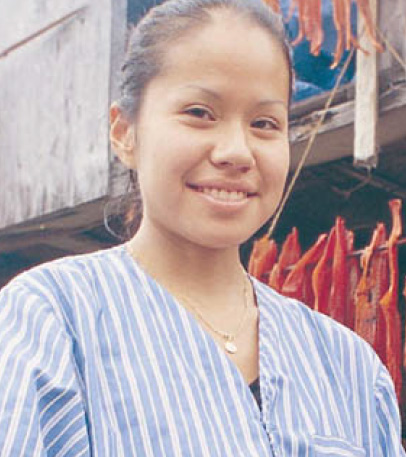
Eagle clan, Student, Surrey. Interviewed outside her grandfather's smokehouse at Laxgalt'sap.
Rosalie: "We moved to Surrey but come back to Laxgalt'sap every summer. I grew up here. I miss it. My favourite memories were coming across the frozen river. I'll move back eventually.
Since the treaty, we've been able to get better food here. Now fresh fruits and vegetables are available. The health of the people will be better. My oldest son was born by coal oil lamp. Now health care is more accessible. They talk about the road opening up to Gingolx — well I remember when the road opened up here in Greenville. There will be changes they said, and there were... The road will help the people in Gingolx.
The treaty has also been positive for jobs. The local village government stresses that. Now my whole family is working. This has happened since the treaty."
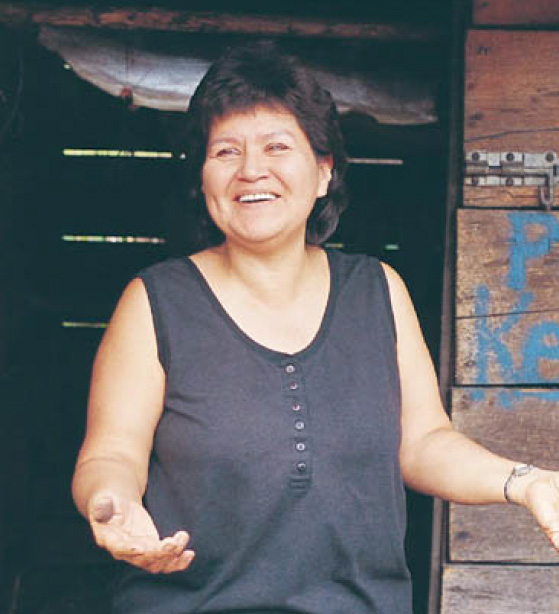
Eagle clan, Homemaker, Surrey. Interviewed at Laxgalt'sap her childhood Village.
"This is the time my daughter and I can stay close. You have to pass on what you know"
Shannon: "I'm going to Kwantlen University College in the fall. I want to study social work. I chose that after my mother attended a Nisga'a government meeting where they were saying how much they need social workers to come and work with the people. The stats of how many people were needed, and how many people need help, were incredible. That's when I decided that I wanted to study to be a social worker and come back to my community and help my people."
Rosalie: "This is what we need: more professionals. Shannon graduated with honours, you know. She was also Athlete of the Year... Coming up here keeps us in touch. I work with Shannon like my mother worked with me. This is the time my daughter and I can stay close. You have to pass on what you know."
Maps - Area of Detail
